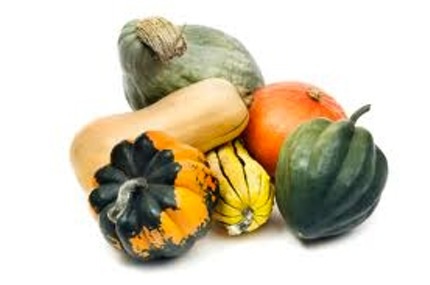
Winter squash have thick, tough shells that protect the sweet, rich flesh inside which makes them excellent storage vegetables. Some varieties are available year-round, but their natural season runs from late summer to mid-winter. Always choose winter squash that feel heavy for their size. Then see how to cook winter squash and find great recipes for squash and pumpkins!
Acorn Squash
Photo © Molly Watson
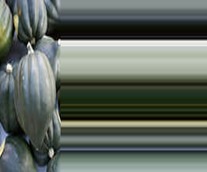
Until the recent rise in popularity of butternut squash, acorn squash were the most commonly available squash in the U.S. They are a great all-around squash, with moist, sweet, tender flesh. They are good for roasting, baking, steaming, mashing, and sauteeing. Smaller ones are perfect for stuffing and make an excellent vegetarian main course for special occasions like Thanksgiving.
Acorn squash are round, with even groves around the entire squash. They are mostly dark green, with occasional splotches of orange and yellow. The flesh is a slightly yellowish pumpkin orange. They tend to weight between 12 oz. and 2 pounds.
Blue Hokkaido
Photo © Molly Watson
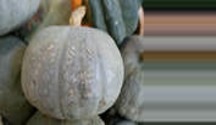
Blue Hokkaido squash (a type of pumpkin) are one of my favorites. As if the gray-blue skin giving way to bright orange flesh weren't a selling point all on its own (and it is in my eyes), these squash have a wonderfully subtle sweet and deeply nutty flavor that stands on its own better than any winter squash. Simply roasted with a bit of slat and butter, the Blue Hokkaido is delicious. It also makes a wonderful vessel for a dramatic stuffed squash and its flesh mashes up nicely into baked good or soups.
Butternut Squash
Photo © Molly Watson

Butternut squash is the sweetest winter squash. Its flesh is thick and moist and hides very few seeds; its peel is comparatively thin and easy to peel. Its a versatile squash that roasts, and sautees quickly. Best of all, is mashes and purees smoothly, with no thick strands or fibrous bits, making it perfect for soups.
Butternut squash is an elongated pear shape with pale tan peel and bright orange flesh. They usually weigh between 2 and 3 pounds.
Delicata Squash
Photo © Molly Watson
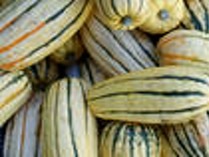
Delicata squash is small, oblong, and cheerfully striped in bright yellow, dark green, and orange. The peel is exceptionally thin and is, in fact, edible (although many, including me, choose not to partake). Because of its thin skin, however, it does not store as long or as easily as other winter squash. Check Delicatas for bruises, cuts, and soft spots before buying. The flesh is sweet, nutty, and a bit drier than other squash with a distinct corn-like flavor. It is particularly delicious roasted with butter or stuffed and baked.
Delicate squash tend to weigh less than a pound.
Hubbard Squash
Photo © Molly Watson
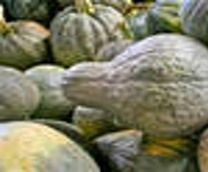
Hubbard squash are about the largest winter squash you'll find for sale (besides field pumpkins, that is). For that reason, they are often sold in pre-cut and seeded chunks of a size more appealing to home cooks. Hubbards are remarkably sweet with a clear pumpkin flavor. They sweeten as they're stored and their extra-thick skins help them store through the winter (up to five months if kept properly cool and dry). Hubbard squash are at their best when roasted. Try them seasoned with rosemary and black pepper or roasted and the mashed with plenty of butter and warm spices like cumin or nutmeg.
Hubbard squash are very large tear-shaped squash with skins that range from dark green to a pale grayish blue.
Kabocha Squash
Photo © Molly Watson
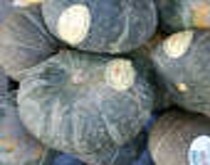
Kabocha squash have a remarkably sweet and tender flesh with a slightly nutty flavor. The peel is really more of a rind and is difficult to cut. The dense, smooth, sweet flesh is so tasty it needs very little fuss in preparation. Roasting it or slicing and baking it with a bit of butter or oil and salt are all this delicious squash needs. The dense flesh also holds its shaped with cooked, even in liquids, which makes it perfect for using as chunks in soups or steamed dishes. It pairs well with ginger and sesame as well.
Kabocha squash are large, round, and squat. They are dark green and mottled, often with bumpy skin and make lovely table decoration until they're cooked.
Pumpkins - Heirloom & Sweet Pumpkins
Photo © Molly Watson
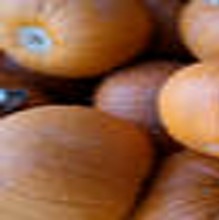
Pumpkins! Yes, pumpkins are winter squash. Field pumpkins, like those used for jack o' lanterns, have dry, flavorless flesh. They can be used as baked tureens for soup, but are otherwise best left for carving and decoration. Some varieties, however, can be roasted or turned into soups just like other scrumptious winter squash. Look for French varieties, pumpkins labeled "Cinderella" pumpkins, Blue Hokkaido (see above) and Red Kuri (see below).
"Sugar pie" and other smaller, sweet pumpkins make for great eating and can be used just like Acorn Squash. The smaller specimens can be hollowed out, roasted until tender, and filled with savory custards or small portions of soup for a fun dinner party treat.
Look for pumpkins labeled sweet, sugar, or cheese pumpkins. You can bake, roast, mash, or puree these eating pumpkins just like other winter squash.
Red Kuri Squash
Photo © Molly Watson
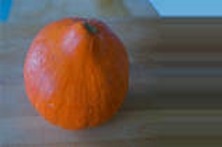
The red kuri squash looks like a small, red-orange pumpkin without the deep ridges in the sides. The flesh is bright orange and has a mellow, somewhat nutty flavor. The flesh is good in soups or baked goods, and the red kuri's small size makes it perfect for stuffing and roasting.
Spaghetti Squash
Photo © Molly Watson
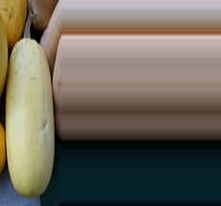
Spaghetti squash are all about the texture. Once cooked the flesh pulls apart into thick, slightly crisp, spaghetti-like strands. Many people then serve this stranded flesh with tomato sauce. I don't find that's the best use of this juicy, mild squash. It is delicious buttered and salted or cooked in a gratin or casserole in a creamy sauce or with plenty of cheese.
Spaghetti squash are large, weighing in over 3 pounds, with pale yellow-white skin.
Sweet Dumpling
The yellow skin with bright orange stripesmakes this small, terribly cute squash hard to resist. The flesh is starchy with a slight corn flavor. The small size makes them perfect for stuffing and roasting.
Turban Squash
Photo © Molly Watson
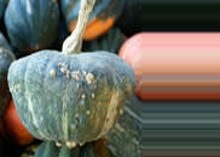
Turban squash come in lovely, irregular, turban shapes and a range of mottled green, orange, and yellow colors. They have interested bumpy skin and are widely used as decoration. They can, unlike decorative gourds, be roasted and eaten. They have a floury texture that works well in soups, and large ones make excellent edible soup tureens when roasted until tender and filled with soup.
Turban squash have a mild flesh that takes well to a wide range of seasonings.
